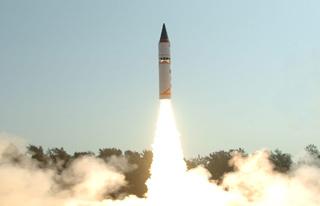
By Suman Chowdhury
India's Agni missile project was initiated by the Defence Research & Development Organisation (DRDO) as part of the Integrated Guided Missile Development Programme (IGMDP) in the year 1983.
Initially conceived as a technology demonstrator project in the form of a re-entry vehicle, the project was later upgraded to a full-fledged ballistic missile programme.
Agni missile system
The Agni missile system is an Intermediate-range ballistic missile (IRBM) of India. The surface-to-surface missile has, so far, been designed and developed in five variants – Agni-I, Agni-II, Agni-II Plus, Agni-III and Agni-V.
AGNI-I
Agni-I is the first missile of the Agni series. It was first tested at the Interim Test Range in Chandipur, Orissa in 1989. Later, two more tests were conducted on 29 May, 1992 and 19 February, 1994. These tests were technology test-beds (TTBs) for developing vehicle structure, integration, navigation and control, flight dynamics and re-entry vehicle technology.
Agni-I has a range of around 700 kms. The missile can be fired from road-mobile launchers. It is propelled by solid fuel, giving it a shallow re-entry angle. Maneuvering RV body-lift aerodynamics give it the ability to correct trajectory errors and reduce thermal stresses. During its reentry phase, the missile uses all carbon composite structure for protecting the payload.
Agni-I has currently been inducted in the Indian Army.
AGNI-II
AGNI- II is a medium range ballistic missile with the capacity to hit targets 2,000 kms away. The missile can carry a nuclear payload of 1,000-kg. It has a length of 20 metres, a diameter of 1.3 metres and weighs 16 tonnes, and is an improvement over its predecessor which had a length of 21 metres and weighed 19 tonnes.
AGNI- II was first tested on 11 April 1999 from the IC-4 pad at Wheeler Island, Balasore. The second test flight on 17 January 2001 demonstrated that the missile can also be launched from a road TEL (Transporter-Erector-Launcher) vehicle.
Agni-II incorporates accurate terminal navigation and guidance system, which constantly updates information about the missile flight path using ground-based beacons, improved accuracy by a factor of at least three over that of the Agni-I. The surface-to-surface missile was recently launched in May, 2010 off an island in Orissa. The test was carried out by the Strategic Forces Command (SFC) of the Indian Army.
Agni-II has also been inducted in the missile arsenal of the Indian Army.
AGNI-II PLUS
Known as the Agni-II Plus, Agni-II Prime or A2, this nuclear-capable missile was developed by the DRDO to fill the gap in the range between Agni-II and Agni-III. While Agni-II has a range of more than 2,000 km, Agni-III can target places more than 3,000 km away.
The two-stage, surface-to-surface missile has a range of about 2,500 km. The 17-tonne missile is 20 metres long, capable of carrying nuclear warheads of one tonne.
The missile was recently test-fired from the Integrated Test Range (ITR) at Wheeler Island off Orissa coast on December 10, 2010. But within moments of take-off from a specially designed truck, the missile plunged into the Bay of Bengal following a deviation in its trajectory.
AGNI-III
Agni-III is an intermediate-range ballistic missile developed by India as the successor to Agni-II. The ballistic missile has a range of 3,500 km- 5500 km, which means that India is capable of engaging targets deep inside its neighbouring countries. The missile’s Circular Error Probable (CEP) is within 40 meters range, which makes it one of the most sophisticated and accurate ballistic missiles of its range in the world.
The first test for Agni III was conducted from Wheeler Island off the Bhadrak coast on July 9, 2006. The launch was not successful due to some anomaly in the first stage. Later on, the subsequent test of the missile on April 12, 2007 from the Wheeler Island off the coast of Orissa was successful.
In the latest launch, in February, 2010, India again successfully tested Agni-III.
AGNI-V
Agni-V (5,000-6000 km) is an Inter-Continental Ballistic Missile (ICBM). It is the first canistered road-mobile ballistic missile in India’s military arsenal, bringing possible targets in almost the whole of China and Pakistan within striking range.
An intercontinental ballistic missile (ICBM) is a missile with a long range (greater than 5,500 km or 3,500 miles) typically designed for nuclear weapons delivery.
Agni-V is a three stage solid fueled missile with composite motor casing in the third stage. Two of the three stages of the solid-propellant missile are made of composites, making it lighter. While 60 per cent of the sub-systems are similar to those of the 3,500-km-range Agni-III, the rest comprises of new and advanced technologies like the ring laser gyroscope and accelerometer, which provide navigation and guidance.
Agni-V will be able to carry multiple warheads and will have countermeasures against anti-ballistic missile systems. The missile is specially tailored for road-mobility. With the missile’s canister having been successfully developed, all of India's future land-based strategic missiles will be canisterised as well.
Another major technological breakthrough that will boost up the Agni-V is the Advanced Systems Laboratory's (ASL) success in developing and testing MIRVs (multiple independently targetable re-entry vehicles). An MIRV, atop an Agni-V missile, will comprise of three to 10 separate nuclear warheads. Each warhead can be assigned to a separate target, separated by hundreds of kilometers; alternatively, two or more warheads can be assigned to one target.
The missile, according to experts, is similar to the Dongfeng-31A missile that raised quite a few eye-brows during China’s National Day Military Parade in Beijing on October 1, 2009.
Agni-V is India’s most ambitious strategic missile project. It is expected to provide a major tactical advantage as it can be launched from anywhere in the country. The test-firing of the missile will help India join the elite club of nations with the capability to produce ICBMs.
Agni-V in comparison with other international ICBMs
| Key Facts |
Agni-V | RT-2UTTH Topol M | LGM-30 Minuteman | Dongfeng-31A |
| Type | Intercontinental ballistic missile |
Intercontinental ballistic missile | Intercontinental ballistic missile | Intercontinental ballistic missile |
| Origin | India | Russia | USA | China |
| Service status |
Under development (Design completed) | December 1997 - Russian Strategic Rocket Forces |
1962 (Minuteman I), 1965 (Minuteman II), 1970 (Minuteman III) | In service |
| Range | 5000-6000 km | 11,000 km |
13,000 km | 10,700-11,200 km |
| Launch Platform |
8 x 8 Tatra TELAR (Transporter erector launcher) & Rail Mobile Launcher (canisterised missile package) | Silo, road-mobile TEL |
Silo | Road mobile, 8X8 tractor truck + 8-wheel trailer; or silo |
| Engine | Three-stage, all composite, solid propellant | Three-stage solid propellant |
Three solid-propellant rocket motors; first stage - Thiokol TU-122 (M-55); second stage - Aerojet-General SR-19-AJ-1; third stage - Aerojet/Thiokol SR73-AJ/TC-1 | Three-stage, solid propellant |
Courtesy:
DRDO
The Hindu
Press Information Bureau
 Previous Article
Previous Article













The Indian Air Force, in its flight trials evaluation report submitted before the Defence Ministry l..
view articleAn insight into the Medium Multi-Role Combat Aircraft competition...
view articleSky enthusiasts can now spot the International Space Station (ISS) commanded by Indian-American astr..
view article